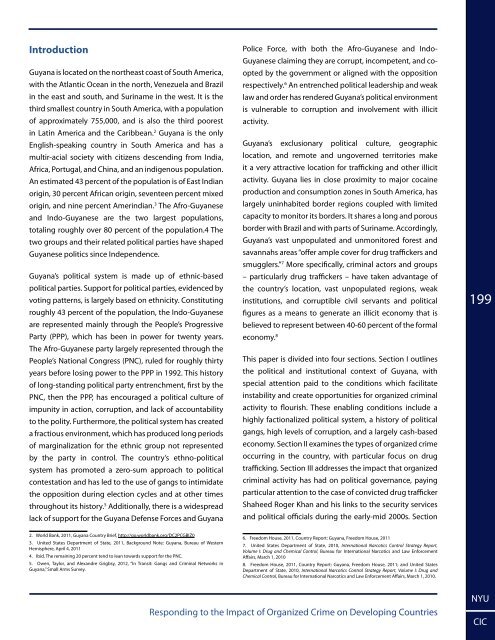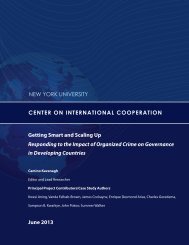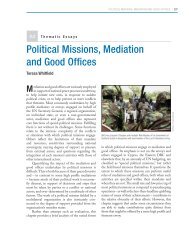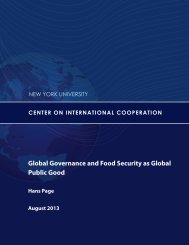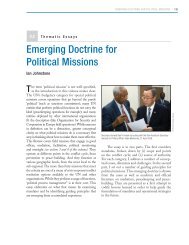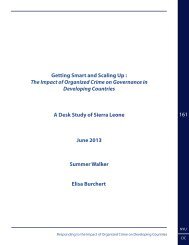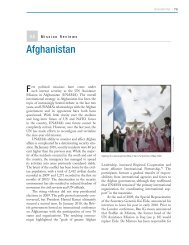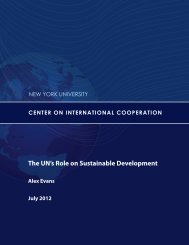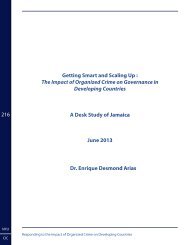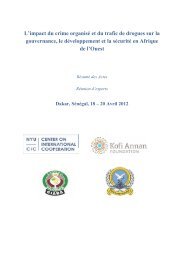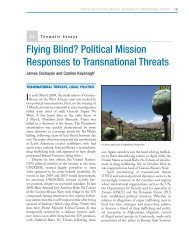here - Center on International Cooperation - New York University
here - Center on International Cooperation - New York University
here - Center on International Cooperation - New York University
You also want an ePaper? Increase the reach of your titles
YUMPU automatically turns print PDFs into web optimized ePapers that Google loves.
Introducti<strong>on</strong><br />
Guyana is located <strong>on</strong> the northeast coast of South America,<br />
with the Atlantic Ocean in the north, Venezuela and Brazil<br />
in the east and south, and Suriname in the west. It is the<br />
third smallest country in South America, with a populati<strong>on</strong><br />
of approximately 755,000, and is also the third poorest<br />
in Latin America and the Caribbean. 2 Guyana is the <strong>on</strong>ly<br />
English-speaking country in South America and has a<br />
multir-acial society with citizens descending from India,<br />
Africa, Portugal, and China, and an indigenous populati<strong>on</strong>.<br />
An estimated 43 percent of the populati<strong>on</strong> is of East Indian<br />
origin, 30 percent African origin, seventeen percent mixed<br />
origin, and nine percent Amerindian. 3 The Afro-Guyanese<br />
and Indo-Guyanese are the two largest populati<strong>on</strong>s,<br />
totaling roughly over 80 percent of the populati<strong>on</strong>.4 The<br />
two groups and their related political parties have shaped<br />
Guyanese politics since Independence.<br />
Guyana’s political system is made up of ethnic-based<br />
political parties. Support for political parties, evidenced by<br />
voting patterns, is largely based <strong>on</strong> ethnicity. C<strong>on</strong>stituting<br />
roughly 43 percent of the populati<strong>on</strong>, the Indo-Guyanese<br />
are represented mainly through the People’s Progressive<br />
Party (PPP), which has been in power for twenty years.<br />
The Afro-Guyanese party largely represented through the<br />
People’s Nati<strong>on</strong>al C<strong>on</strong>gress (PNC), ruled for roughly thirty<br />
years before losing power to the PPP in 1992. This history<br />
of l<strong>on</strong>g-standing political party entrenchment, first by the<br />
PNC, then the PPP, has encouraged a political culture of<br />
impunity in acti<strong>on</strong>, corrupti<strong>on</strong>, and lack of accountability<br />
to the polity. Furthermore, the political system has created<br />
a fractious envir<strong>on</strong>ment, which has produced l<strong>on</strong>g periods<br />
of marginalizati<strong>on</strong> for the ethnic group not represented<br />
by the party in c<strong>on</strong>trol. The country’s ethno-political<br />
system has promoted a zero-sum approach to political<br />
c<strong>on</strong>testati<strong>on</strong> and has led to the use of gangs to intimidate<br />
the oppositi<strong>on</strong> during electi<strong>on</strong> cycles and at other times<br />
throughout its history. 5 Additi<strong>on</strong>ally, t<str<strong>on</strong>g>here</str<strong>on</strong>g> is a widespread<br />
lack of support for the Guyana Defense Forces and Guyana<br />
Police Force, with both the Afro-Guyanese and Indo-<br />
Guyanese claiming they are corrupt, incompetent, and coopted<br />
by the government or aligned with the oppositi<strong>on</strong><br />
respectively. 6 An entrenched political leadership and weak<br />
law and order has rendered Guyana’s political envir<strong>on</strong>ment<br />
is vulnerable to corrupti<strong>on</strong> and involvement with illicit<br />
activity.<br />
Guyana’s exclusi<strong>on</strong>ary political culture, geographic<br />
locati<strong>on</strong>, and remote and ungoverned territories make<br />
it a very attractive locati<strong>on</strong> for trafficking and other illicit<br />
activity. Guyana lies in close proximity to major cocaine<br />
producti<strong>on</strong> and c<strong>on</strong>sumpti<strong>on</strong> z<strong>on</strong>es in South America, has<br />
largely uninhabited border regi<strong>on</strong>s coupled with limited<br />
capacity to m<strong>on</strong>itor its borders. It shares a l<strong>on</strong>g and porous<br />
border with Brazil and with parts of Suriname. Accordingly,<br />
Guyana’s vast unpopulated and unm<strong>on</strong>itored forest and<br />
savannahs areas “offer ample cover for drug traffickers and<br />
smugglers.” 7 More specifically, criminal actors and groups<br />
– particularly drug traffickers – have taken advantage of<br />
the country’s locati<strong>on</strong>, vast unpopulated regi<strong>on</strong>s, weak<br />
instituti<strong>on</strong>s, and corruptible civil servants and political<br />
figures as a means to generate an illicit ec<strong>on</strong>omy that is<br />
believed to represent between 40-60 percent of the formal<br />
ec<strong>on</strong>omy. 8<br />
This paper is divided into four secti<strong>on</strong>s. Secti<strong>on</strong> I outlines<br />
the political and instituti<strong>on</strong>al c<strong>on</strong>text of Guyana, with<br />
special attenti<strong>on</strong> paid to the c<strong>on</strong>diti<strong>on</strong>s which facilitate<br />
instability and create opportunities for organized criminal<br />
activity to flourish. These enabling c<strong>on</strong>diti<strong>on</strong>s include a<br />
highly facti<strong>on</strong>alized political system, a history of political<br />
gangs, high levels of corrupti<strong>on</strong>, and a largely cash-based<br />
ec<strong>on</strong>omy. Secti<strong>on</strong> II examines the types of organized crime<br />
occurring in the country, with particular focus <strong>on</strong> drug<br />
trafficking. Secti<strong>on</strong> III addresses the impact that organized<br />
criminal activity has had <strong>on</strong> political governance, paying<br />
particular attenti<strong>on</strong> to the case of c<strong>on</strong>victed drug trafficker<br />
Shaheed Roger Khan and his links to the security services<br />
and political officials during the early-mid 2000s. Secti<strong>on</strong><br />
199<br />
2. World Bank, 2011, Guyana Country Brief, http://go.worldbank.org/DC2PCGBIZ0<br />
3. United States Department of State, 2011, Background Note: Guyana, Bureau of Western<br />
Hemisp<str<strong>on</strong>g>here</str<strong>on</strong>g>, April 4, 2011<br />
4. Ibid. The remaining 20 percent tend to lean towards support for the PNC.<br />
5. Owen, Taylor, and Alexandre Grigbsy, 2012, “In Transit: Gangs and Criminal Networks in<br />
Guyana,” Small Arms Survey.<br />
6. Freedom House, 2011, Country Report: Guyana, Freedom House, 2011<br />
7. United States Department of State, 2010, Internati<strong>on</strong>al Narcotics C<strong>on</strong>trol Strategy Report,<br />
Volume I: Drug and Chemical C<strong>on</strong>trol, Bureau for Internati<strong>on</strong>al Narcotics and Law Enforcement<br />
Affairs, March 1, 2010<br />
8. Freedom House, 2011, Country Report: Guyana, Freedom House, 2011; and United States<br />
Department of State, 2010, Internati<strong>on</strong>al Narcotics C<strong>on</strong>trol Strategy Report, Volume I: Drug and<br />
Chemical C<strong>on</strong>trol, Bureau for Internati<strong>on</strong>al Narcotics and Law Enforcement Affairs, March 1, 2010.<br />
Resp<strong>on</strong>ding to the Impact of Organized Crime <strong>on</strong> Developing Countries<br />
NYU<br />
CIC


